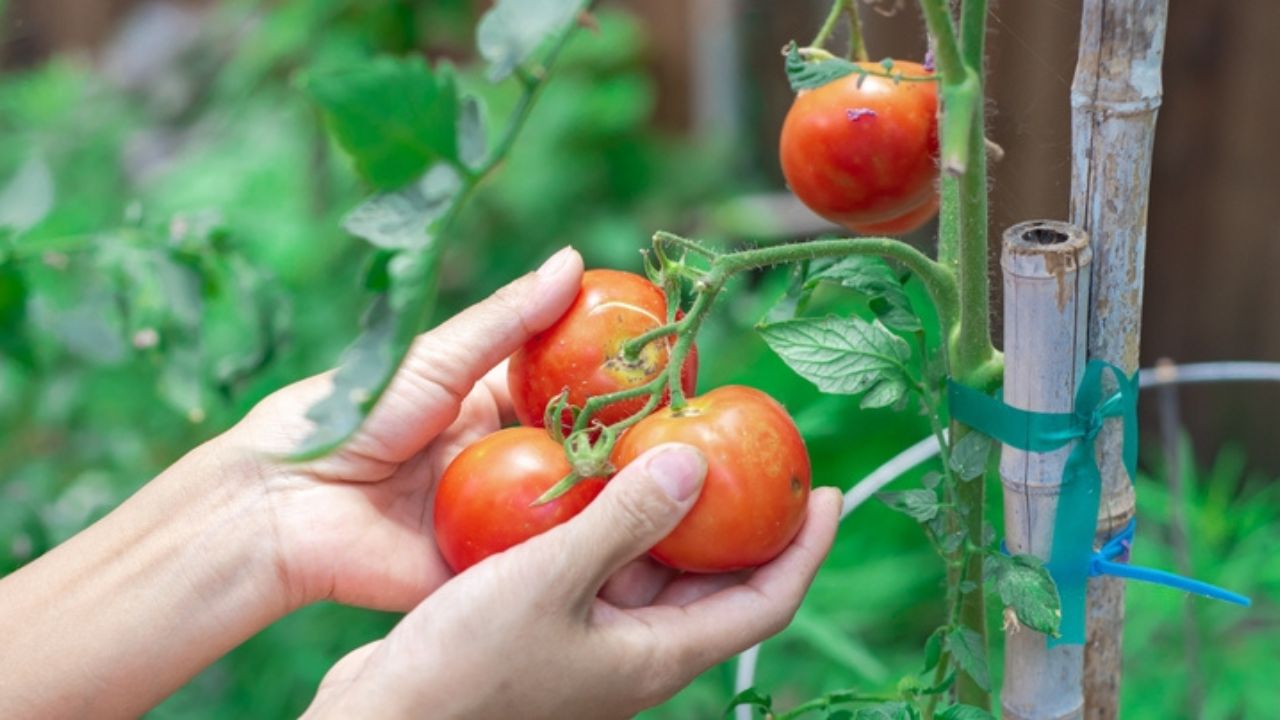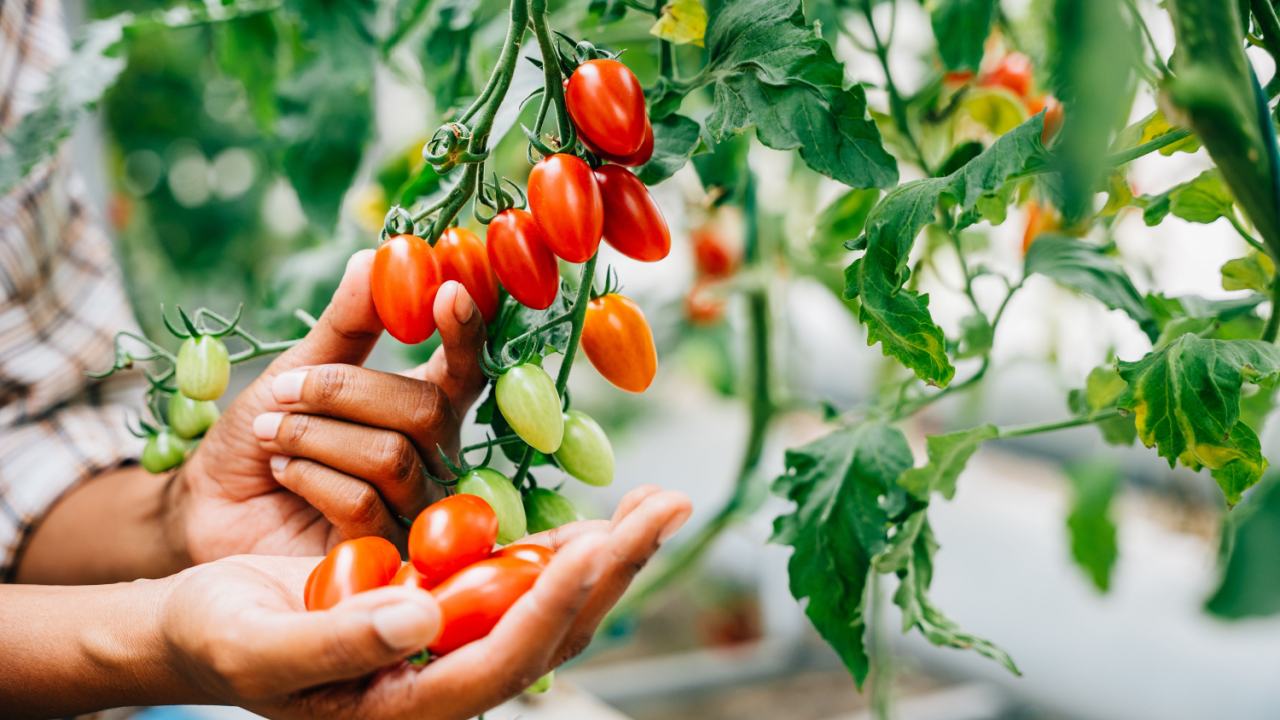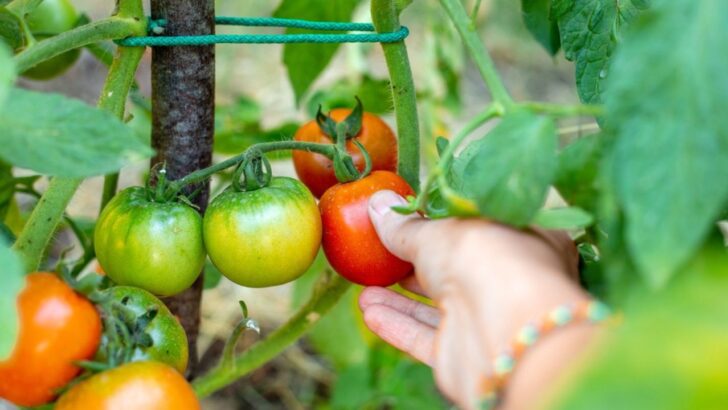If left alone, tomato plants will spread across your garden beds, creating a big, messy pile of foliage. Trying to harvest through that mess of leaves can be a challenge busy gardeners don’t need, not to mention that extra space a sprawling tomato plant can take up. However, using various staking methods, you can cultivate healthy tomato plants in less space and enjoy an increased and extended harvest.
Let’s explore what is the best way to stake tomato plants. These are all the ways I’ve found work best as a seasoned gardener that have either worked for myself or fellow friends who love tomatoes as much as me.
Key Takeaways
- Proper staking is essential for optimal tomato plant growth, quality, and yield.
- Choosing the proper staking method is critical, and several options are available, such as a single stake, cage, Florida weave, T-post, string, and bamboo teepee methods.
Do You Have to Stake Tomatoes?

Image Credit: Shutterstock.
No, you don’t HAVE to stake them. Tomato plants can and will grow without any help. But here’s what can happen if you let tomatoes grow without staking them:
- They’ll take up a lot more space in your garden and give your garden a messy look
- Without staking, the leaves will lie on the ground and will be susceptible to disease
- Poor air circulation can facilitate fungal diseases like blight and powdery mildew
- The low-hanging foliage of unstaked tomato plants provides a hiding place for pests such as slugs, snails, and insects that can cause significant damage to the plant and its fruits
- You’ll get a lower yield
- You’ll have a harder time harvesting, as locating and reaching ripe tomatoes can be challenging in a tangle of sprawling vines and foliage
Why Staking Tomato Plants is Important

Image Credit: Shutterstock.
Staking your tomato plants is like giving them a helping hand to reach their full potential! It’s an essential part of the growing process that can help improve the quality and quantity of tomatoes you harvest.
Staked tomato plants look better, stay healthier, produce more, and are easier to harvest.
The type of stake used is important since it needs to support the plant as it grows. Stakes should be sturdy enough so they don’t break under the weight of the plant and tall enough so they won’t need to be replaced during the season, and support indeterminate tomato plants that can grow as high as 12 feet.
The Best Way To Stake Tomato Plants

Image Credit: Shutterstock.
Growing a successful tomato plant requires more than good soil and sunshine. You also need to ensure your plants are adequately staked, as it can help them grow healthier and taller while producing larger, tastier tomatoes. (See how you can help your tomatoes grow faster.)
Staking allows you to maximize the sunlight that gets to each tomato plant so they can take full advantage of the growing season. There are several different methods for staking tomatoes depending on their size and growth habits, so let’s explore the best way to stake tomato plants in your garden!
Choose the Right Staking Method for Your Garden

Image Credit: Shutterstock.
Choosing the correct staking method for your garden is critical to successful tomato growth, so picking the best option is essential.
When selecting a support system, consider what works best with your soil type and plant variety. For instance, wooden posts can be used in heavier clay soils as they provide better stability than metal cages or trellises, which may topple over due to weight as the plant grows.
1. The Single Stake Method

Image Credit: Shutterstock.
The single-stake method is a great option for gardeners looking for an efficient way to support their tomato plants. This staking system involves selecting a sturdy material, such as a wooden or stiff plastic stake or bamboo pole, and burying it deep into the soil near the base of the tomato plant soon after planting it, being careful not to hurt the plant.
Make sure to bury these sturdy stakes deep into the ground to provide extra stability during windy weather conditions. Tie the stem to the stake with yarn, twine, or strips of fabric as the plant grows. Or, make it easy on yourself and buy a pack of reusable clip rings.
2. The Cage Method

Image Credit: Shutterstock.
Tomato cages come in a few shapes: cone-like, square, or triangular. I’ve used the cone-shaped ones with minimal success, as they have a narrow base that can’t support a tall, top-heavy plant.
I have found that the square-shaped cages are a better option, as they have a larger base. But, if you grow indeterminate tomatoes with heavy fruit, they might still fall over from the weight of the fruit.
Wire tomato cages might be best used for staking determinate tomatoes and small, lightweight tomatoes such as cherry tomatoes (here are the 20 best cherry tomatoes to grow).
An FYI, removing suckers is not easy when using this method.
3. The Florida Weave Method

Image Credit: Shutterstock.
The Florida weave is a method of supporting tomato plants using two supporting stakes and twine (or string) to weave the tomato plants in place.
This technique eliminates the need for additional stakes and clips. It is recommended to start trellising tomato plants when they are under 2 feet tall for easier management and to avoid damaging more established plants.
4. The Metal T-Post Method

Image Credit: Shutterstock.
Metal T-posts are a great choice for staking tomato plants due to their ease of use, cleaning/sanitizing capabilities, easy installation and removal, longevity, and strong support. These metal stakes can last for decades if properly treated and stored.
T-posts offer unbeatable strength and support, capable of bearing the weight of any tomato variety, including those with large fruits. They can be used in various staking methods, such as the Florida weave, where twine and posts support the plants.
5. The Bamboo Teepee Method

Image Credit: Shutterstock.
You can create a fun and unique teepee for your tomato plants using bamboo stakes! This method is excellent for those who want to add an attractive aesthetic to their garden without sacrificing the strength of support.
For example, one gardener I know used this technique to grow cherry tomatoes up a 9-foot tall teepee structure – with plenty of space between the branches for airflow, providing vines with ample sunlight access.
6. The Lattice Method

Image Credit: Shutterstock.
Lattices can serve as a wall to tie your tomatoes to. This works well if you plant tomatoes near your porch or a wooden fence. Attach the lattice to the fence, and you have nice support for your tall-growing plants.
Tips From Gardeners For Staking Tomato Plants

Image Credit: Shutterstock.
Need more ideas? Try these:
- Plant tomatoes against a wire fence and tie the branches to it as they grow. Use bamboo to support the fence and prevent it from leaning under the weight of the plants.
- Utilize livestock fencing to stake tomatoes. Tie the plants to the fence or weave their branches through the holes, giving them a sturdy structure.
- Use powder-coated metal stakes instead of galvanized steel ones. The powder-coated stakes are sturdier and offer better support for the tomato plants.
- Use hog or cattle fencing, which measures 4’x8′ and is raised 2′ above the ground. This method helps keep the plants off the ground and prevents them from sprawling.
I hope you found at least one idea for staking your tomatoes. Now enjoy a summer filled with delicious tomatoes.



How To Save A Dying Tomato Plant
Wednesday 28th of June 2023
[…] stake your tomato plants […]
How To Grow Tomatoes In Containers - 5 Tips For Success
Wednesday 28th of June 2023
[…] Learn more about staking tomatoes here. […]
How Far Apart To Plant Tomatoes For Better Yield
Sunday 25th of June 2023
[…] tips for staking tomatoes for a higher yield […]